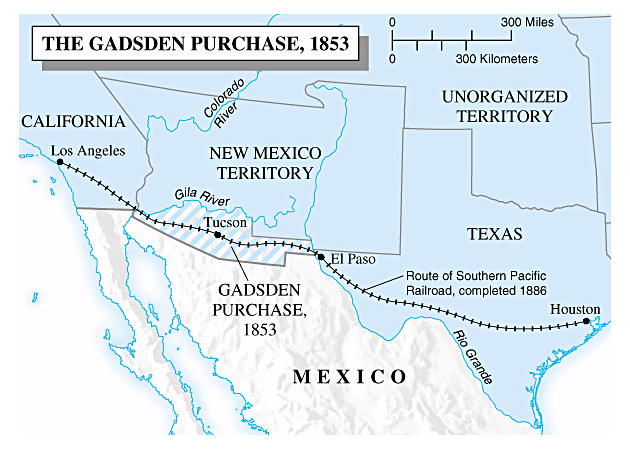
The Gadsden Purchase allowed for the southern transcontinental railroad to be built
The Gadsden Purchase allowed for the southern transcontinental railroad to be built


"The reclamation scheme is both feasible and desirable." - James Gadsden
James Gadsden was born on May 15, 1788, in Charleston, South Carolina. After graduating from Yale College in 1806 he begins to take part in the business affairs in his city until 1812 when he was put as lieutenant of engineers in the US Army. From here he took care of various affairs, predominately in Florida with the removal of Seminole Indians. Eventually, in 1840, he was given the post of president of a railroad in South Carolina. However, Gadsden's most important role was as a US minister to Mexico in 1853. Here he was instructed to negotiate a treaty with Mexico for the purchase of territory beneath the Gila River which was the most desirable route for a transcontinental railroad. He succeeded by gaining territory consisting of now southern New Mexico and Arizona. This exchange of $10 million for 30,000 square miles of land cemented James Gadsden's place in history as the key figure behind, what is known today as the Gadsden Purchase.
The Gadsden Purchase, also known as the Treaty of La Mesilla, was signed on December 30, 1853, between US minister James Gadsden and Mexican President, Antonio de Santa Anna. The main reason behind this $10 million purchase was for obtaining land this was crucial for the construction of the southern railroad that was to be run from California to Texas as shown in the picture. This purchase is known as the sale of Mesilla Valley as it assigned to the United States 30,000 square miles of northern Mexico, now southern Arizona and southern New Mexico.
Once the purchase was completed, residents who lived in the area were also given the same protection and rights as were given to those of the area involved in the Treaty of Guadalupe Hidalgo. Despite the Gadsden Purchase creating increased tension over the United States' payment and failing to resolve border attacks, it did cement the southern border of present-day Unites States. It ended the United States' conquest for land, despite the fact many thought the United States would continue to expand into Mexico.
